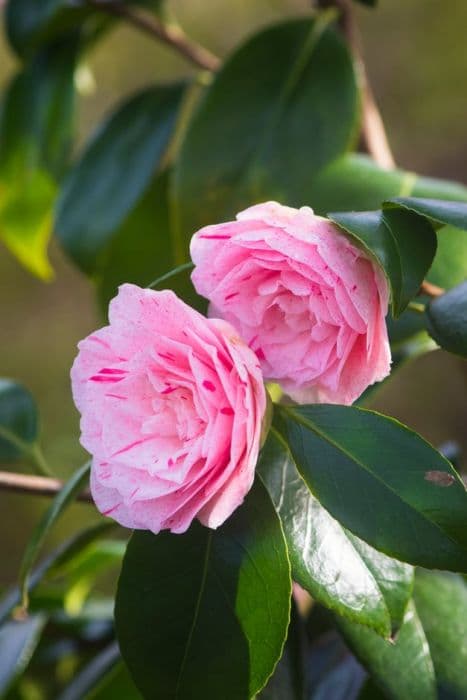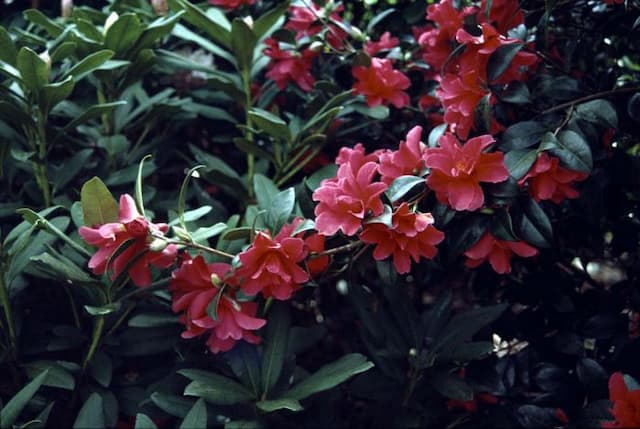Japanese Camellia Camellia japonica 'Carter's Sunburst'

ABOUT
The Camellia japonica 'Carter's Sunburst' is a stunning ornamental plant with a lush, glossy green foliage that creates a splendid backdrop for its eye-catching blooms. These flowers are truly the star attraction of this cultivar, unfurling in a spectacular fashion that resembles the rays of the sun. The petals are a soft pink, often edged with deeper shades creating a delightful contrast, and are arranged in a full, peony-like form with numerous petaloids adding to their opulence. At the heart of the bloom, a burst of golden stamens adds an extra touch of radiance, enhancing the sunburst effect for which this variety is named. Flowers emerge progressively throughout the blooming season, each one commanding attention with its large and showy display. The Camellia japonica 'Carter's Sunburst' maintains an evergreen presence, ensuring that even outside its blooming period, the plant contributes to the garden's greenery with its dark, leathery leaves that have a smooth and glossy texture. These leaves can be oval to elliptical in shape, with a subtle serration along the edges. Together, the vibrant blooms and rich foliage of the Camellia japonica 'Carter's Sunburst' create an enchanting display, making it a beloved choice for gardeners looking to add a touch of elegance and dramatic flair to their landscapes.
About this plant
 Names
NamesFamily
Theaceae.
Synonyms
Carter's Sunburst Camellia, Japanese Camellia.
Common names
Camellia japonica 'Carter's Sunburst'.
 Toxicity
ToxicityTo humans
The Japanese Camellia is not considered to be toxic to humans. There are no well-documented symptoms of poisoning from ingesting this plant. However, it is generally advised not to consume parts of ornamental plants due to the potential presence of naturally occurring compounds that may cause discomfort or be harmful in large quantities.
To pets
The Japanese Camellia is generally recognized as non-toxic to pets as well. Ingestion of this plant is not known to cause any significant symptoms of poisoning in animals such as cats and dogs. As with humans, it is always best to prevent pets from eating plants not meant for consumption to avoid any potential gastrointestinal upset.
 Characteristics
CharacteristicsLife cycle
Perennials
Foliage type
Evergreen
Color of leaves
Green
Flower color
Pink
Height
6-10 feet (1.8-3 meters)
Spread
6-10 feet (1.8-3 meters)
Plant type
Shrub
Hardiness zones
7-9
Native area
Japan
Benefits
 General Benefits
General Benefits- Ornamental Appeal: The Camellia japonica 'Carter's Sunburst' offers showy, double flowers with pink and white petals that provide aesthetic value to gardens and landscapes.
- Long Blooming Season: This camellia has a blooming season from late winter to early spring, providing color when most other plants are dormant.
- Evergreen Foliage: It retains its glossy, dark green leaves throughout the year, which adds continual texture and color to gardens.
- Shade Tolerance: The plant performs well under partial shade conditions, making it a good choice for shaded garden areas where many flowering plants may not thrive.
- Drought Resistance: Once established, it has moderate drought tolerance, reducing the need for frequent watering.
- Wildlife Attraction: The flowers can attract pollinators such as bees, adding to the biodiversity of the garden.
 Medical Properties
Medical PropertiesThis plant is not used for medical purposes.
 Air-purifying Qualities
Air-purifying QualitiesThis plant is not specifically known for air purifying qualities.
 Other Uses
Other Uses- The Camellia japonica 'Carter's Sunburst' petals can be used in salad dressing for subtle flavoring and decorative purposes, as edible flowers are becoming increasingly popular in gourmet cuisine.
- The plant's waxy leaves can be polished and used as ornamental additions in floral arrangements, providing a glossy and sturdy green backdrop for more delicate flowers.
- With proper treatment, the wood of Camellia japonica can be crafted into small objects such as buttons, which can be an eco-friendly alternative to plastic.
- The spent blooms of the Camellia can be scattered over beds as natural mulch, providing nutrients as they decompose and enhancing soil quality.
- Leaves from the Camellia japonica can be dried and used as bookmarks, keeping in theme with traditional Japanese arts and crafts.
- Camellia petals can be pressed and used in paper making, adding texture and color to handmade paper for artistic purposes.
- The plant can serve as a living fence or privacy screen in gardens due to its dense growth habit.
- Camellia flowers can be used to dye fabrics with a range of colors from pale shades to a deeper pink, depending on the dyeing process and other materials used.
- Dried blooms from the Camellia japonica can be incorporated into potpourri mixtures, contributing a light fragrance and a splash of color.
- The sturdy branches of Camellia japonica can be used in the creation of natural wreaths or other rustic decorative items for home decor.
Interesting Facts
 Feng Shui
Feng ShuiThe Camellia is often associated with positive Feng Shui energy, symbolizing love, affection, and admiration. To use Camellias in Feng Shui, place them in the southwest area of a garden or room to enhance love and romance. They can also be used in the south for recognition and the east for family harmony and health.
 Zodiac Sign Compitability
Zodiac Sign CompitabilityThe Camellia is not used in astrology practice.
 Plant Symbolism
Plant Symbolism- Adoration and Devotion: Camellia japonica, commonly known as the Japanese camellia, often symbolizes deep admiration and devotion, making it a wonderful gift to express feelings of affection.
- Perfect Loveliness: The intricate, multi-petal structure of the 'Carter's Sunburst' cultivar epitomizes perfection and is associated with the ideal of perfect beauty and loveliness.
- Longevity and Faithfulness: The long blooming period of the Japanese camellia represents enduring qualities, signifying long life, faithfulness, and commitment.
- Refined Beauty: Due to its exquisite form and the rich history of its cultivation, the camellia is often connected with refined beauty and sophistication in various cultures.
- Desire or Passion: Red and pink hues common in camellias, including variants of 'Carter's Sunburst', are traditionally linked with feelings of desire or passion, conveying deep emotional messages.
 Water
WaterJapanese camellias, like Carter's Sunburst, should be watered deeply to encourage root growth, typically receiving about 1 to 1.5 inches of water per week. During the growing season, water the plant once or twice a week, depending on the soil moisture and weather conditions. In hotter, drier periods, more frequent watering may be necessary, but allow the top inch of soil to dry out between waterings. Over the winter, reduce watering to compensate for the plant's decreased activity. Do not overwater as this can lead to root rot; well-draining soil is crucial to prevent waterlogging.
 Light
LightFor Carter's Sunburst Japanese camellia, dappled sunlight is ideal, as they thrive under the high, light shade of tall trees. Direct, harsh sunlight can be detrimental, especially in the afternoon, so aim for morning sun followed by afternoon shade. If grown indoors, place them near a window with filtered light to avoid scorching the leaves.
 Temperature
TemperatureJapanese camellias, including Carter's Sunburst, prefer moderate temperatures and will thrive in a range of 40 to 85 degrees Fahrenheit. They can withstand brief dips below this range down to around 10 degrees Fahrenheit. However, prolonged exposure to temperatures outside this range can damage the plant. Ideally, they should be grown in environments that stay within this temperature spectrum to ensure robust growth and flowering.
 Pruning
PruningPrune Carter's Sunburst Japanese camellia to maintain shape and encourage airflow, which can help prevent disease. The best time to prune is just after it finishes blooming in spring, as they set buds on last year's growth. Remove any dead or weak wood, and thin out dense areas but avoid heavy pruning, as this can reduce flowering the following season.
 Cleaning
CleaningAs needed
 Soil
SoilJapanese Camellia 'Carter's Sunburst' thrives in well-draining, acidic soil with a pH around 5.5 to 6.5. A mix of 50% organic matter such as pine bark or leaf mold, and 50% peat moss or a peat-based potting mix is ideal. Adding perlite or sand can improve drainage.
 Repotting
RepottingJapanese Camellia 'Carter's Sunburst' should generally be repotted every 2-3 years. Younger, faster-growing plants may need annual repotting, whereas mature, slower-growing camellias are repotted less frequently.
 Humidity & Misting
Humidity & MistingJapanese Camellia 'Carter's Sunburst' requires high humidity, ideally between 50-60%. To thrive, ensure the surrounding environment is consistently moist but not wet.
 Suitable locations
Suitable locationsIndoor
Place in bright, indirect light with high humidity and acidic soil.
Outdoor
Partial shade, protect from strong winds, acid soil, and consistent moisture.
Hardiness zone
7-9 USDA
 Life cycle
Life cycleThe Japanese camellia 'Carter's Sunburst' begins its life as a seed, germinating in moist, well-drained soil, preferably in partial shade. Once the seedling emerges, it enters the vegetative stage, developing into a shrub with glossy, evergreen leaves. As it matures, typically within 2-5 years, it enters the flowering stage, producing large, showy pink flowers with a distinctive ruffled appearance, usually from late winter to early spring. After pollination, the flowers will develop into dry capsules, containing seeds that can be dispersed to propagate new plants. Throughout its life, Camellia japonica 'Carter's Sunburst' will undergo seasonal growth cycles, with active growth in the spring and summer, and a dormancy period in the winter in colder climates. With proper care, the plant can live for many years, sometimes over a century, continuing to flower annually.
 Propogation
PropogationPropogation time
Spring-Early Summer
The Camellia japonica 'Carter's Sunburst', commonly known as the Japanese camellia, is typically propagated through semi-hardwood cuttings. This method involves taking a cutting of about 4 to 6 inches (10 to 15 cm) from the current year's growth, which has begun to mature but is not yet fully woody. The best time to take these cuttings is in late summer to early autumn. Leaves on the lower half of the cutting are removed, and the cut end can be dipped in rooting hormone before being placed in a moist potting mix. The environment should be kept humid and the temperature should remain warm to encourage rooting. A plastic cover or propagation chamber can be used to maintain these conditions. After several weeks, the cuttings should develop roots and can then be transplanted.









